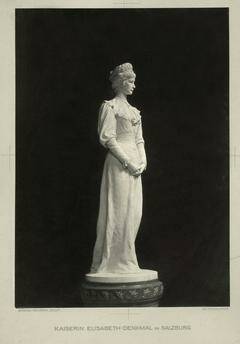
On the 15th juli 1901 in Salzburg this statue of Empress Elisabeth was revealed.
This was in the garden of the luxury hotel de l'Europe, next to the train station.
Attending the reveal were alot of her family members, for example:
- Emperor Franz-Joseph
- Archduchess Marie-Valerie with her husband Franz Salvator and children Ella, Hubert and Franz-Karl
- Archduchess Elisabeth "Erzi" with a lady-in-waiting.
- Princess Gisela and her husband Leopold and their Sons Georg and Conrad
- Archduchess Auguste, Gisela's daughter, with her husband Josef-August and their son Franz-Joseph
- Archduke Ludwig Victor.
Only a few days earlier, on July 12, 1901,the entire district of Froschheim had been named Elisabeth-Vorstadt in honor of the Empress on the initiative of Sylvester Oberberger and Mayor Franz Berger.
There was a reason this took place on the 15th of July and why on this exact location:
It was on the 15th of July that empress Elisabeht along with her lady-in-waiting Countess Irma Stráray were on a trip from Bad Ischl to Bad Nauheim.
The train stopped for a short while on the train station in Salzburg.
Sisi and Irma didn't wanna sit their waiting time for the train to continue the journey by sitting, so they made a walk in the parks between the Hotel de l'Europe and the trainstation.
This was also the last time Empress Elisabeth left her footprints in on Austrian soil.
When the journey continued after Bad Nauheim,Germany, her last stop was Geneva, Switserland.
There she was murdered by an Italian Anarchist.
Made of snow-white Laas marble, the Elisabeth statue rests on a high, inscribed round pedestal. The base is made of Salzburg marble. It is made of reddish rock, so-called Hofbruch. The finish is a delicate garland of stylized edelweiss flowers,which were among the Empress's favorite flowers.
The financing came from donations, with a large contribution made by Archduke Ludwig Viktor,the brother of Emperor Franz Joseph. It was created in 1900 by the artist and then rector of the Vienna Art Academy, Professor Edmund Hellmer.

Already covered with boards in the last year of the war in 1918, the monument was completely demolished in May 1925 and taken to Hellbrunn. There it stood for a short time near the trout pond before it was later placed in a roundel framed with hedges in the rear part of the park near the castle wall.
Towards the mid-1990s, in the course of several redesigns of the Bahnhofsplatz (since 1926 Südtirolerplatz), efforts were made to return the monument to its original location and to integrate it into the green areas in front of Salzburg Central Station as part of the architectural redesign.
In October 2002, after 77 years of exile in Hellbrunn, the monument finally returned to its original location.



Reactie plaatsen
Reacties